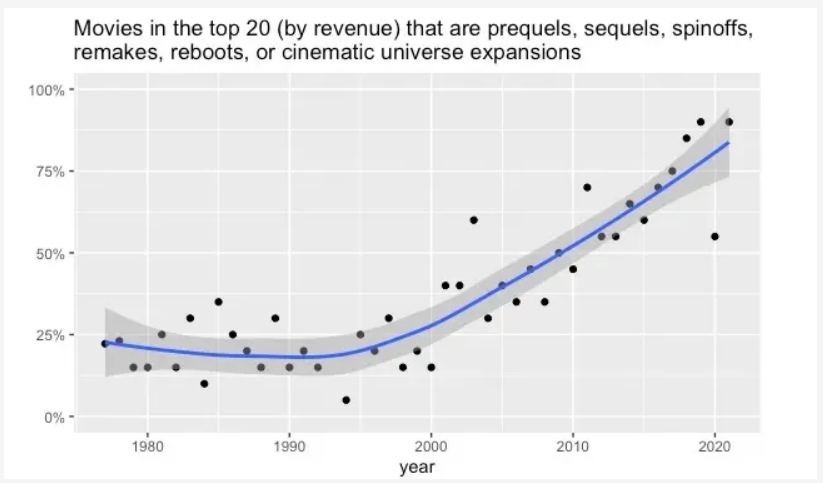-
Posts
2,413 -
Joined
-
Last visited
-
Days Won
91
richardmurray's Achievements
Single Status Update
See all updates by richardmurray
-
Time to Break Up Hollywood
Hollywood is trapped in a death spiral, with streaming giants struggling to profit while smothering the industry itself. Finally the writers stood up. But will it be enough?
MATT STOLLER
MAY 14, 2023Today I’m writing about the biggest Hollywood labor dispute in decades, as screenwriters enter their third week striking against streaming giants like Disney, Netflix, Paramount, Warner Bros, and Comcast. Far from a narrow conflict over money, this fight is existential, a question of whether America can be a place where stars are born and movies are made.
As one striker put it < https://strikegeist.substack.com/p/daily-digest-why-this-strike-feels > , the strike is “about the whole corporate dominance of America.”
(The Ankler’s excellent Strikegeist < https://strikegeist.substack.com/ > newsletter is covering the strike, and I highly recommend it if you are interested in what’s going on day-to-day.)
Of America’s many inventions, reality TV does not rank as highly as, say, the semiconductor, the laser, the polio vaccine, or manned flight. But from Candid Camera in the 1940s to MTV’s The Real World in the early 1990s, the medium of reality TV has been as influential in its own way as rock music and hip hop. But today, it’s Great Britain, not America, creating many of the most popular reality shows
Here are some of the shows that got their start in the U.K., and then were licensed for an American audience: American Idol, America’s Got Talent, X-Factor, Dancing with the Stars, Wife Swap, Undercover Boss, Super Nanny, Who Wants to be a Millionaire. And there are hundreds more. In the U.K, independent producers have increased their TV related revenues from £1.5 billion in 2004 to more than £2.6 billion in 2017.
What happened? Put simply, governments changed laws so that independent producers gained bargaining leverage in the U.K., and lost it in the U.S.
Let’s start with the U.K. In the early 2000s, the British government embarked on a strategy to grow its independent production industry. It facilitated something called the “Terms of Trade,” < https://cmpa.ca/wp-content/uploads/2019/01/Appendix-C-Oliver-Ohlbaum-Associates-2018-The-impact-of-the-UK-te...-1.pdf > a broadcaster code of conduct to remedy the bargaining asymmetry between dominant broadcasters and independent producers. This pact required four big public channels in the UK - BBC1, ITV, Channel 4 and Channel 5 - to commission < https://www.smallscreenbigdebate.co.uk/__data/assets/pdf_file/0024/221955/annex-2-statement-future-of-public-service-media.pdf > 25% of their production from independent producers, and to allow those producers to retain copyrights from their work they could license abroad.
This was a soft break-up of the industry along vertical lines, and it made the U.K a great place to do business. As the CEO of the firm that makes American Idol, The X Factor, and Britain's Got Talent said, "There is no other country where you have these terms of trade. In the UK, it's brilliant!" In 2010, independents held 50% of the market, beating in-house network programming. Exports of British content exploded.
In the U.S., by contrast, legal changes over the last thirty years stripped independent producers of their bargaining power with distributors, diminishing the ability to create great products. In 2019, I laid it out in one of my first newsletter issues, titled The Slow Death of Hollywood < https://mattstoller.substack.com/p/the-slow-death-of-hollywood > , explaining why weirdly themed movies like Back to the Future became smash hits in the 1980s, and why that wouldn’t happen today.
In 1985, theater owners had more choices about what content to sell, and could decide to distribute content that was well-liked and popular without assuming a massive barrage of marketing would force them to stock the most popular stuff immediately. So they could afford to show different movies, experiment, and then bring in the popular ones over time. The industry was more decentralized. Stars, directors and writers with good track records, studios, distributors, movie theaters, critics, and moviegoers shared power.
[This market structure harkens] back to bitter battles in the 1930s and 1940s between New Deal antitrust attorneys and studio heads, which culminated in the Paramount Decrees of 1948 < https://www.justice.gov/atr/paramount-decree-review > and the end of the autocratic so-called ‘Studio System.’ These decrees forced studios to sell their theaters, and prevented them from engaging in tying and bundling practices to force theater owners to take their films. New Hollywood, with countercultural stars like Jack Nicholson, emerged in the 1960s to revamp the industry. In 1985, weird popular movies like Back to the Future took advantage of this open market structure.
A similar situation existed in the television industry, which was broken apart in 1970 by Richard Nixon’s FCC with Financial Interest and Syndication Rules (‘fin-syn’) < https://www.csmonitor.com/1991/0404/finsyn.html > , and a related rule called the Prime-Time Access Rule (PTAR). These rules blocked TV networks from distributing their own content in prime time, opening the market for TV content to third party producers who would take more creative risks. The Cosby Show, Seinfeld, The Mary Tyler Moore Show, and All in the Family were some of the results of this policy choice to open up the TV market.
Both the Paramount Decrees and the Fin-syn rules were designed to eliminate conflicts of interest by splitting the studio from the distribution. Studios had to create high quality work, and if they didn’t, distributors could choose to sell someone else’s art.
The rules structured a profitable and high-quality industry, with different kinds of TV shows and movies. Media was a series of markets, from movie theaters and prime time TV, to hundreds of local TV networks for syndication, to video tapes and DVDs, to foreign markets. Creators experimented, while audiences ruled with their preferences. Hollywood is a politically left-wing place, but conservative religious hits, like The Passion of the Christ, got into theaters, and sold tickets.
In the 1980s, antitrust enforcers, influenced by Chicago School scholars like Robert Bork, became far more tolerant of concentration economy-wide. This legal revolution had significant implications for movies. In 1995, the top five movie chains owned a third of U.S. theaters, with the biggest, Carmike, owning < https://www.nytimes.com/interactive/2016/03/07/business/media/amc-biggest-movie-theater-chain.html> around 2,500. By 2016, the top five held over 53% of the movie theaters in the country, with the largest, AMC, owning 8,380.
This consolidation changed movies. In the late 1990s, giant new multiplexes “jolted the Hollywood power structure,” < https://www.wsj.com/articles/SB885343258697290000 > as theater operators played the biggest hits on several screens at once. Films began to do most of their business in the first few weeks, so well-branded tent pole movies with strong IP - aka Marvel-style movies - displaced word of mouth. As Adam Mastroianni noted with this chart, movies, along with much of pop culture, became an oligopoly. < https://www.experimental-history.com/p/pop-culture-has-become-an-oligopoly?s=r >

The Clinton administration enacted another legal change by ending fin-syn rules, causing a merger boom of content and distribution. Immediately, for instance, Castle Rock Entertainment, the production company behind shows like Seinfeld, sold out to Turner Broadcasting, which in turn sold out to Time Warner. Disney bought ABC, and then rolled-up a series of rivals < https://mattstoller.substack.com/p/its-time-to-break-up-disney-part > to acquire large amounts of well-known intellectual property - like Marvel and Star Wars.
Then came streaming, which wasn’t very important at first. Prior to 2010, the major studios sold movies to theaters, and TV shows to cable and TV networks. Several sold to Netflix, which they saw as just another distributor. But in 2010, the Obama administration approved the merger of NBC and Comcast, a further erosion of the vertical separation at the heart of the Paramount Decrees and the fin-syn rules.
Technological innovation happens along the legal framework it is born into, so streaming, which could have decentralized had it happened in another era, did the opposite.
When Comcast bought NBC, Netflix, then a minor player, feared it would lose access to content from studios. So it began buying its own movies and shows, combining distribution and production as the first studio-streamer. Apple and am*zon, for whom Hollywood revenues were a rounding error, eventually entered the business. Netflix, Apple, and am*zon put pressure on the traditional studios, who were judged based on profit and loss. Studios realized Wall Street was valuing Netflix stock more highly as a ‘tech’ company. They wanted in on that as well. All except Sony followed Netflix and became studio-streamers.
But something wasn’t right with the streaming model Netflix introduced. There was no way to know ratings or box office take, since Netflix held its own data without third party auditors. Its then-CEO, Reed Hastings, pretended Netflix used its data to scientifically know what users wanted. But that wasn’t true. (See “The Algorithm is a Lie.” < https://entertainment.substack.com/p/the-algorithm-is-a-lie?s=w > ) Netflix was just overpaying for content, and losing money to acquire market share, a technique known as predatory pricing (that used to be illegal until the Supreme Court de facto legalized < https://supreme.justia.com/cases/federal/us/509/209/ > it in 1993.)
Netflix’s model was an attack on the bargain between creators and studios at the heart of the industry. This bargain is that everyone who makes movies or shows - production houses, studios, writers, actors, or directors - split the profits from any individual piece of content, profits generated by selling movies or shows into actual markets. Producers, for instance, often retained the intellectual property of a show, and licensed it. Traditional labor compensation packages, known as ‘residuals,’ are based on theatrical releases, or what ratings TV shows achieved when broadcast. Additionally, both categories might qualify for additional compensation through syndication or DVD sales, foreign market sales, and sometimes streaming. (It’s why the cast of Friends is still making millions of dollars a year even today.)
When Netflix sought to fully integrate the production and distribution, this bargain broke down, because there were no markets or prices to use to value anything. Netflix paid creators an upfront fee, and then that content was on Netflix, with no opportunity to syndicate or sell it elsewhere. Beyond breaking down price signals, Netflix wouldn’t even tell creators how their shows did in terms of ratings. It also refused to allow American production houses to retain IP. Other studios copied Netflix, upending the labor model for content. No one knew what anything was worth.
The lack of market signals screwed up the industry because markets, as it turns out, have an important function in Hollywood. They represent a feedback loop to the studios, telling executives the preferences of the audience, based on whether the audience (or advertisers) are willing to pay. The tacky way to understand this dynamic is that when a movie did well at the box office, other studios would often copy that kind of movie, in hopes of appealing to the large audience that saw the original. But what happens when you can’t get distribution for mid-market movies because the few theater chain owners don’t want it? What happens when there are no TV ratings because it’s all streamed? What happens when, as happened during the pandemic, there is no box office?
Obviously, at some level, people are still paying money in the form of subscription fees. But decisions for what to make happen about individual pieces of content are difficult without this feedback from the audience. A creative executive can’t, after all, green light a streaming service, they can only green light a movie or TV show.
When pricing went away, when customers were simply paying a subscription fee every month instead of buying tickets or DVDs, executives had no way to know what to make or how to value anything. As just one example, in 2021, Warner Brothers put their whole slate of films onto their streaming service at the same time as they went into theaters, revealing how executives were mis-pricing their products. Another illustration of a deep structural problem with the industry is that bankable movie stars, the most important commodity in Hollywood, are aging, because you can’t break new stars.
In an attempt to monopolize, studio-streamers accidentally transformed a high-wage, high-profit business into a low-wage low-profit commodified one. For a time, this decline in industry health wasn’t obvious. Netflix had told Wall Street a story that its overall goal was to get customers locked in, and this convinced the street to give the capital to make lots of content regardless of profit. Other studios followed, overpaying for content in the hopes of being the last man standing, in the era of what was known as “Peak TV.” < https://slate.com/culture/2023/03/peak-tv-over-golden-age-hbo-streaming.html > As Discovery board member John Malone put it < https://www.hollywoodreporter.com/business/business-news/john-malone-talks-streaming-wars-1235264416/ > , “Everyone went for this mad Oklahoma land rush of streaming … That was a fool’s errand.”
The lock-in was a mirage, as consumers switched services to find content they wanted to watch. No one, as it turns out, wanted a streaming service, they wanted individual shows and movies. Vertically integrated streaming services, contrasted with markets where consumers pay for what they want, aren’t very profitable. HBO, Peacock, and Paramount all lost money < https://www.vox.com/recode/2023/1/5/23539590/streaming-losses-netflix-hbo-peter-kafka-media-column > in the first three quarters of 2022, and this year, Disney’s streaming services raised prices < https://deadline.com/2023/05/disney-pulling-content-off-streaming-in-strategic-rethink-1235362374/ > and removed content, and still can’t make a penny.
Most of the consolidation discussed so far is vertical, where studios and distributors combined. But throughout this period, traditional mergers, where rivals bought rivals, also continued. In 2019, Disney bought Fox, shrinking the number of major studios into a narrower oligopoly (and cutting the output of films < https://theankler.com/p/the-disney-fox-deal-whos-right?utm_source=post-email-title&publication_id=15657&post_id=97369692&isFreemail=false> ). Last year, Discovery bought Time Warner, combining two big buyers of reality TV.
Consolidation, combining both production and distribution, and shrinking the number of studios, led to budget cuts. For writers, this meant smaller writer rooms, shorter seasons, and worse terms. Writer pay fell by 14% over < https://www.wcvb.com/article/what-do-striking-hollywood-writers-want/43791834 > the last five years, with sweatshop conditions < https://theankler.com/p/showrunner-crisis-its-a-sweatshop > even for those with the most creative control, the showrunners. Others felt it too; independent TV production houses, such as firms who create reality TV shows, struggled. They no longer have any choice but to sell to one of a few studio-streamers. Streamers demanded the intellectual property of anything they bought, which meant independent production houses began working as contract players for a fee, almost like chicken farmers or gig workers. There was no point in creating something great, since all the upside went to the streaming giants.
Nothing in Hollywood, in other words, is working now that the underlying pricing system has been reduced in importance. The studio-streamers aren’t making money, the workers aren’t getting compensated like they used to, and the cultural relevance of Hollywood is declining. (And that last point is very weird, because Hollywood should have been able to take advantage of the remarkable telecommunications revolution of the last thirty years, but hasn’t.)
This industry-wide collapse is at the heart of the writers strike that’s taking place right now, ever since the industry contract with screenwriters expired at the beginning of the month. What the Writer’s Guild of America (WGA) wants, is a fix to the devastation vertical integration has wrought on the industry. Their official demands are more money, access to data on how their shows do, as well as also minimum staffing requirements for shows and better lengths of employment for writers. To add to the pressure, over the next few months, the Director’s Guild and the Screen Actors Guild will also be renegotiating < https://abc7.com/hollywood-writers-strike-los-angeles-guild-of-america-directors/13229141/#:~:text=The Writers Guild of America's,Editor in Chief Cynthia Littleton. > their contracts.
Some of the WGA demands address the power imbalance more directly than others. More residuals is a standard labor demand, while better data on streaming would actually ameliorate industry structure. Minimum staffing requirements are a bit more controversial, according to The Ankler’s Richard Rushfield. But fundamentally, the problem the writers face is much bigger than an unfair deal. It is in fact the same problem that everyone - writers, actors, directors, producers, crew members, and executives - all face; the industry itself is badly structured, and there is no political leadership < https://theankler.com/p/rushfield-the-very-bad-choices-that > among studio CEOs to address the dysfunction.
Most in Hollywood feel in their gut the dysfunction, and the proof is in the support unions are showing one another. Believe it or not, labor solidarity in the industry is rare. During the 2007 writers strike, for instance, Teamsters would drive past picket lines and give the strikers the middle finger. Two weeks ago, however, Teamster leader Lindsay Dougherty told < https://strikegeist.substack.com/p/rushfield-day-3-netflix-bears-the > writers at a strike rally, “If you put up a line, the trucks will fucking stop... The only way we’re gonna beat these mother fuckers is if we do it together."
It’s not just unions. Agents are pitching in, even though agents and writers had been at war relatively recently. And the producers are backing the writers as well, quietly. One strike captain told Elaine Low that “they’ve received boxes of doughnuts from producers who refused to share their names,” but that “the anonymous drive-by doughnuts were well received.” It’s remarkable that producers are afraid to have their names associated with a strike they support, but in a sense, the fear is the point.
Even the Wall Street financiers themselves see the problem, in the form of stagnating share prices. From their point of view, however, the problem isn’t that studio-streamers are too powerful, but that they are too weak. As media tycoon John Malone last year told the New York Times, studios, especially smaller ones, don’t have enough pricing power, and will ”inevitably have to combine in order to try and become profitable.” This view is near-consensus in the C-Suite; former WarnerMedia CEO Jason Kilar recently wrote in the WSJ < https://www.wsj.com/articles/jason-kilar-chaotic-streaming-wars-11670177734 > , he expects there will only be two or three studios remaining after another merger wave, and a bevy of billionaires from Comcast and Discovery are all planning < https://puck.news/lazard-fears-nbcu-c-suite-tea-leaves/?_cio_id=f6c60604e79a01a8c408&utm_campaign=The+Daily+Courant+-+LEADS+(5%2F1%2F23)&utm_content=The+Daily+Courant+-+LEADS+(5%2F1%2F23)&utm_medium=email_action&utm_source=customer.io > for the “inevitable” merger of NBC and Warner Bros. Discovery. And am*zon is reportedly interested < https://nypost.com/2023/03/28/am*zon-reportedly-interested-in-buying-amc-entertainment/ >
in buying the AMC theater chain.
In other words, rather than returning the industry to profitability by separating out distribution and studios once again, the goal is to further consolidate Hollywood to squeeze pricing power out of consumers and creators.
And that’s why this fight is existential. For the strikers, the problem is how to negotiate a deal providing a reasonable living making commercially viable TV shows and movies. For the studio-streamers, however, preserving a domestic creative industry is fundamentally unimportant. Their problem is a lack of pricing power, aka too much competition among relatively undifferentiated streaming services who must bid against each for both talent and audience. Their way out is to drive a hard bargain, while trying to engineer another set of mergers.
As the Entertainment Strategy Guy notes < https://entertainmentstrategyguy.com/2023/05/09/sending-a-strategy-postcard-from-strike-land/> , and as the reality TV imports from the U.K. show, there is now production capacity all over the world, and shows and movies are regularly imported into the U.S. The South Korean show Squid Game was the most popular show on Netflix, ever. This CNBC headline says it all: “‘Squid Game’ success shines a light on how cheap it is to make TV shows outside the U.S.” < https://www.cnbc.com/2021/10/16/netflixs-squid-game-success-shines-light-on-international-discounts.html > As unimaginable as it might be to think of Hollywood itself disappearing, why couldn’t TV and movies just be one more industry the U.S. outsources?
In other words, this strike is more than just a problem for the writers, it’s about whether the U.S. wants to have the capacity to make commercially viable movies and television shows. If we do, then we’ll need a real political coalition to break up the studio-streamers.
It’s a good moment to have this conversation, because the strike has focused everyone in Hollywood on problems in the industry. Different stakeholders in the industry are going to have to build a political argument for a revival of some form of the fin-syn or Paramount Decrees. We need Congressional hearings, and industry commissions with recommendations. It could be a Terms of Trade type arrangement so producers get to keep IP, or it could be something else. But it will have to split the industry giants so they are either distributors or studios, but not both. Markets have to exist again. I don’t know how to address consolidated theater chains, but that’s a problem as well.
Finally, I would note that this strike is just one of a series of battles over who controls our media systems. There are of course many legislative proposals and antitrust suits to address social media and big tech, but it goes far beyond that. Last year, for instance, the Biden antitrust division blocked < https://mattstoller.substack.com/p/book-publishing-mega-merger-blocked > a merger of Penguin and Simon & Schuster, foiling consolidation in books. At academic publishing monopolist Elsevier, 40 scientists just resigned < https://www.salon.com/2023/05/10/elsevier-editor-resignation-neuroimage/ > from editorial positions at a journal on brain imaging to protest the “greed” of their publisher.
There is also anger in the national security world, and on the right, over this problem. Congressman Mike Gallagher, from the Special Select Committee on China, led a delegation < https://deadline.com/2023/04/disney-china-bob-iger-mike-gallagher-interview-1235322443/ > to Hollywood to meet with CEOs about Chinese influence in the industry (which is another consequence of consolidation). There’s a public fight between Tucker Carlson and Fox News, which is about media control as well. Carlson was fired, and was subjected < https://www.axios.com/2023/05/07/fox-news-tucker-carlson > to a non-compete agreement to block him from creating a rival. And who else is fighting with studio giant Disney? That would be Florida Governor Ron DeSantis, and at some level this conservative anger is with corporate power. Maybe a ‘break up Hollywood studios’ battle cry would have some pull with them.
America is a fractured society, but the truth is, most of us have something in common. We love storytelling, and we don’t want a small group telling us what stories we can tell one another. A coalition is possible to save this magnificent art form. When push comes to shove, very few Americans, in Hollywood or elsewhere, are happy “about the whole corporate dominance of America.”
THE IMPACT OF TERMS OF TRADE ON THE UK's TELEVISION CONTENT PRODUCTION SECTOR
PRODUCING PUBLIC SERVICE MEDIA CONTENT
























.thumb.jpg.afc88dfee9cd2927de0c440601caac13.jpg)



.thumb.jpg.ed52910791d00308abb8c218695bec88.jpg)



















































